
21 minute read
FX Luminaire shining strong after 30 years
FX Luminaire
shining strong after 30 years
Advertisement
his year, FX Luminaire celebrates 30 years in business and is proud to look back on three decades of “innovation T in outdoor lighting technology.” Founded in 1989 by Joshua Beadle in San Diego, the company was borne out of the landscape contractor’s dissatisfaction with the quality of the outdoor lighting available to him. He began by making fixtures for his own projects, but the reputation of his quality lighting led to interest from fellow contractors, and FX Luminaire soon became Beadle’s full-time business venture.
Over the years, FX Luminaire has developed controllers, path lights, hardscape fixtures, energy- and money-saving technology, smart lighting systems, and more. Their current focus is on LED technology and fully digital lighting control systems over zoning, dimming, and color changes.
The company was acquired by Hunter Industries in 2009, giving the FX Luminaire greater resources to grow their distribution, increase product development, and offer a strong support system for both employees and consumers. Distributed through landscape supply sources, the products are available for both residential and commercial, adaptable to current lighting specifications.
“I feel a lot of pride for what we have accomplished as a team over the years,” says Ryan Williams, director of marketing. “To think that the company started in a garage and now is a powerhouse in the global environment — it is truly humbling. In the years to come, I expect to see significant advancement into international markets, with a greater focus on efficiencies, flexibility, and control.” | CG
Photo courtesy FX Luminaire
Innovation in outdoor lighting technology
Pre-design collaboration with builder & architect set stage for project success

Photos courtesy Lindgren Landscape Work on this stunning outdoor space earned Lindgren Landscape The ELITE Award for Design/Build.

Lindgren brings Cherry Creek to Fort Collins home
“houghtful planning, phasing and homeowner collaboration are the reasons this project was successful, and our client is T a ‘very happy camper’ (in her words),” says
Georgia Perry, senior designer at Lindgren
Landscape, Fort Collins. “We started the landscape design process before construction of the home began.”
Perry and her team worked with the builder and architect—with whom Lindgren Landscape had partnered with on several projects before—to be sure the transition from the home to landscape was seamless, and to ensure the outdoor living goals of the client were met.
The homeowners have two active young children and a dog, and love to entertain.
Public versus private areas
The property had an expansive and exposed front yard on a corner lot, and by comparison, a small backyard. The final design created both a feeling of grandeur with the very public front yard, as well as feeling of privacy and intimacy in the backyard.
The courtyard in the back was designed as a retreat area with a fireplace, water feature, plants and, importantly, privacy. The area needed sufficient screening to create a visual barrier from intrusive neighbors. Strategic placement of the fireplace and wall, as well as hedges that have grown to provide more screening, were installed. Dense shrubs and trees were also the homeowners’ preference
By Lyn Dean

Backyard retreat space

because they wanted to “bring Cherry Creek” to their Fort Collins home—they wanted a more mature-looking landscape to accompany their sprawling, traditional-style home. All hardscape installations including walls and pavers were chosen to provide architectural continuity with the home.
The sizable front yard was softened with rolling contours and details that add interest.
Planned phasing
Plantings and other installations in the yard were phased to meet short-and long-term budget needs. Hardscapes and the irrigation system were installed the first fall of the project, as were the substructure and utilities for the backyard structures. The next spring, backyard structures were completed and plants were added. Plant material continues to be added, and annual and bulb displays layer showy color throughout the season.
Making the dream come alive
“It’s not just a catchy saying: ‘it takes teamwork to create dreamwork,’” says Perry. “Projects don’t happen without a client who is invested in the long-term vision. Likewise, without a beautifully designed and constructed home, a nice landscape is just a side attraction to the home.” Perry passionately adds that though design is the linchpin, it is the craftsmen and production team who bring it to life. Each piece is critical, and success reigns when they come together. | CG


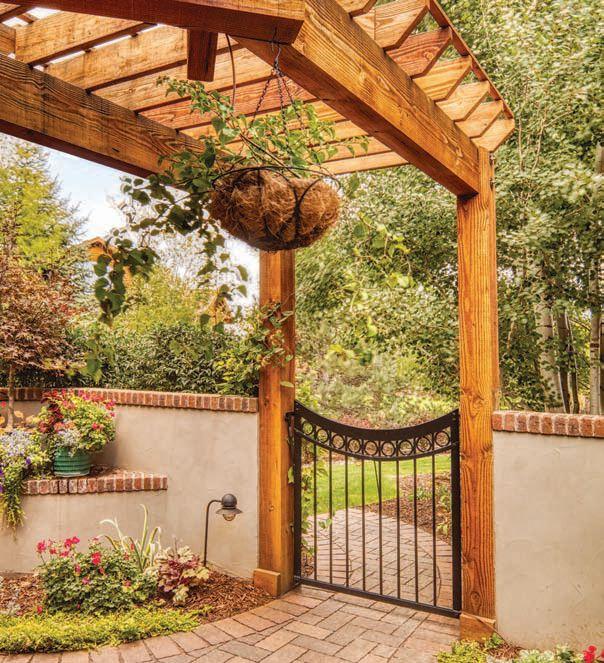
Landscapes soar to new heights with
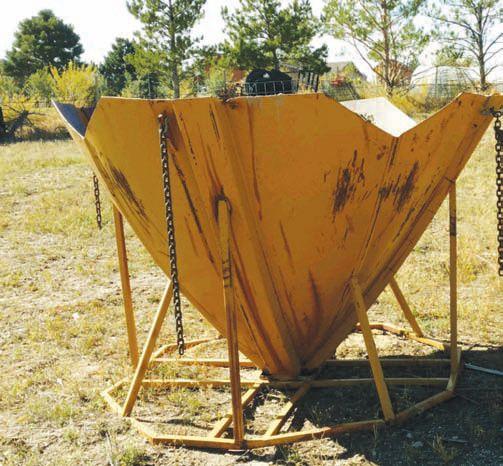
35 years of

Photos courtesy Colorado Tree Spade “ he biggest challenge we face is most people have no idea trees can be moved!” says Susan Pfeifer, founder, Colorado T
Tree Spade, Highlands Ranch. “They tend to think if a tree is in a bad location, they either have to cut it down or just deal with it.”
Pfeifer wants us to think again. Colorado
Tree Spade has been moving trees for 35 years and has numerous success stories with customers ranging from homeowners with small properties to high-profile Front Range personalities with large properties to well-known commercial properties including the Pepsi
Center, Denver Broncos Training Facility and
The Broadmoor. “We still have clients we have worked with since the 1980s,” she says.
Roots of the uprooting business
As a pair of 20-something young adults, Pfeifer and her former husband were finding their way in life, working jobs and managing
transplanted trees Colorado Tree Spade
By Lyn Dean
The “Bigger Digger” is Colorado Tree Spade’s 124-inch spade.
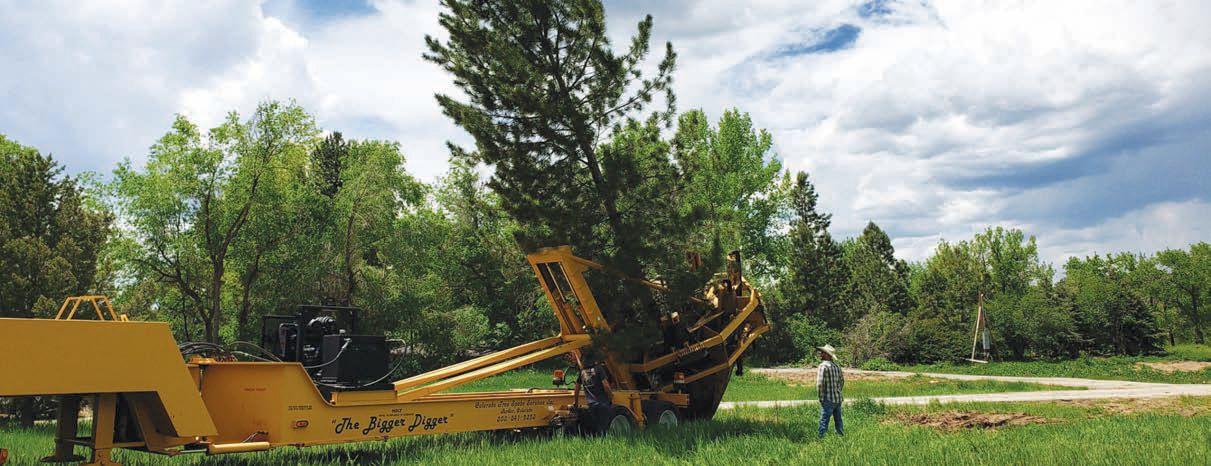
rental properties. A friend of Pfeifer’s father had a tree spade business, and she liked the idea of saving trees and having a positive impact, even before “it was cool to be green.” In 1984, the pair founded the company when they bought their first tree spade, and within a year, they purchased a second spade.
“We quickly learned that when in business for yourself, it seems there are no ‘business’ hours,” Pfeifer says. “We drove trucks during the day, and at night I’d return calls and do the book work.”
Everything they learned was self-taught, from driving the trucks to using the computer and bookkeeping systems. “We were at the top of the class in the school of hard knocks,” reflects Pfeifer. She quit driving the trucks when expecting her first child but continued with the phone calls and office work, and the company hired additional drivers.
The founders continued to balance running their tree spade company and raising two children, while managing rental properties, until about 2006, which was shortly after the marriage and partnership dissolved. Colorado Tree Spade became a woman-owned company.
The employee roster remains small, averaging three to five employees. “Our equipment does the work of 5-10 people,” Pfeifer says. Though she admits staffing is a challenge, as with other businesses in the green industry, she gratefully acknowledges an employee, Jeff Wolff, who has been with the company 30 years. He has seen and done it all when it comes to transplanting trees and is masterful with the trucks.
Biggest tree spade ever!
One the most significant changes in the company’s business was when it started getting into larger machines—those that could handle bigger trees. “We were the first to
have a 110-inch spade custom made. Then we went on to have a 124-inch machine made, the biggest size that could be made as a mobile unit,” says Pfeifer. “This opened up work for us across the nation, not just in Colorado.” Bigger spades are rare, which means Colorado Tree Spade’s fleet can handle bigger tree jobs and can collaborate with other tree movers as subcontractors. Pfeifer sees her company as a partner—not a competitor—with other treemoving companies, and also a partner with landscape companies. “We can help them do their work.”
Currently, the company owns eight spades in various sizes and has the largest fleet and
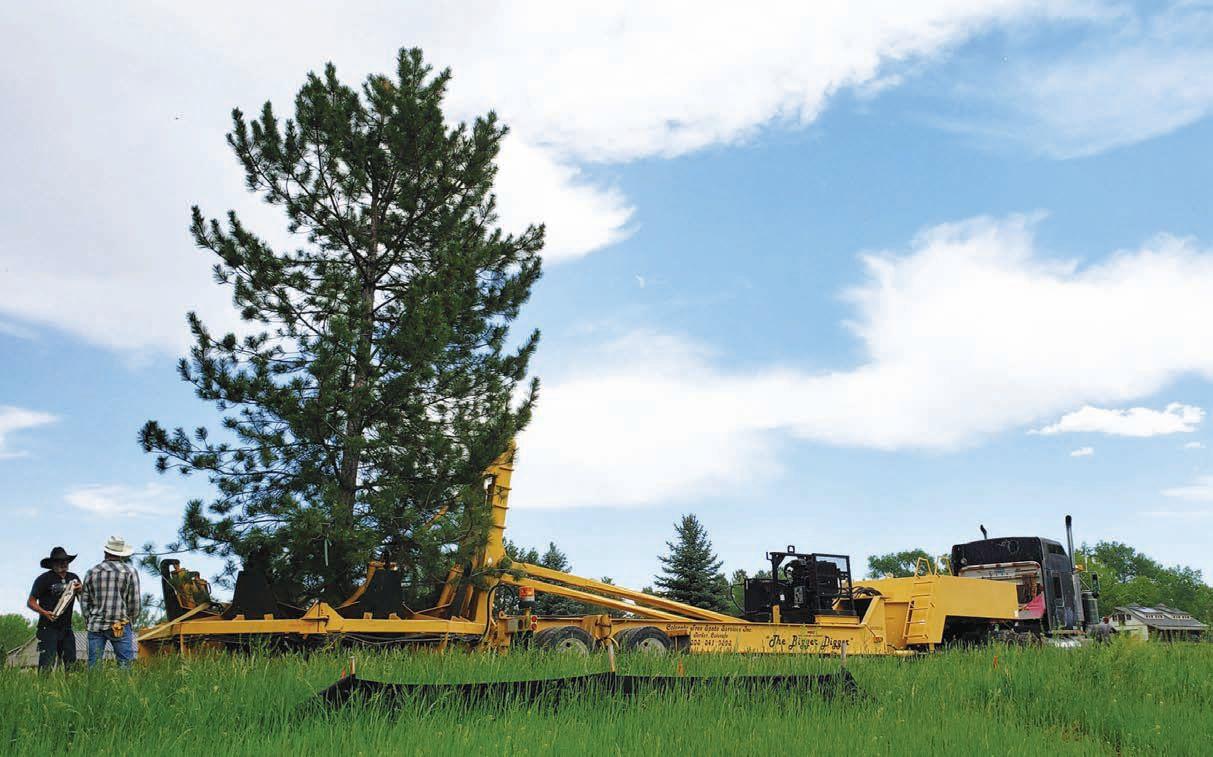
widest variety in the state, and one of the largest in North America, according to Pfeifer.
She adds that the largest tree spade, which can carry trees 40 feet tall with a root ball weighing over 40,000 pounds, is used only to move trees on the same property because the loaded truck is not road legal.
Get the word out about transplanting trees
Educating people that trees can be moved is the biggest challenge of the company. Pfeifer says she meets people both within and outside the industry who say, “I wish I had met you earlier. I had to cut down a tree because I didn’t know other options.”
“Many of these precious trees can be saved!” she declares. “Most new development I see has mature trees that can be saved by transplanting.” With proper access, Colorado Tree Spade can move trees from 4 - 40 feet in height.
She wants more homeowners to know that they can move trees to open a view or block a view, whether they are putting on an addition to their home or adding a pad for their RV. All this can be accomplished by moving trees to more ideal locations.
Anyone who wants a tree, or owns an unwanted tree, or knows someone who wants or owns a tree, is a potential client. Her company can move bigger trees than the ball and burlap trees landscape contractors get from a nursery, and transplanted trees have a high survival rate.
Many of the company’s transplanted trees are moved to a different location on a client’s property or to a different property of the client. Other clients donate unw anted trees to a charitable organization, such as a church property, local parks or schools.
The company has a list of people who want big trees and looks for “homeless trees,” trees that people no longer want.
Tree moving is inherently satisfying
“Moving trees creates a lot of excitement and satisfaction,” says Pfeifer. “On a homeowner’s property, people are in awe of the big, heavy, hydraulic equipment which often draws a small crowd of neighbors.”
Transplanting trees can be cost effective
The company maintains that moving established trees more than 12 to 14 feet in height is more cost effective than buying a similarly sized nursery tree and planting. The cost to buy a 14- to 20-foot tree could be at least $2,000. Colorado Tree Spade says that the average cost to transplant a mature tree starts at about $600 and it has a high likelihood of survival. Importantly, a tree is saved that might have been cut down.
Furthermore, when a tree is removed from a property, typically the recipient pays for the entire move. This means property owners can have their trees removed for free! Better yet, by ‘donating’ the tree to a 501(c)3 charity, the
Photos courtesy Colorado Tree Spade Aaron Pfeifer and Susan Pfeifer

tree owner could receive a tax deduction for the value of the tree!
Passing the torch
Recently, Pfeifer began considering her exit plan for the business. For the past few years, her son, Aaron Pfeifer, a Colorado School of Mines engineering grad, has been a consultant for other businesses, helping optimize operations and strategic planning. Recently, he started working with Colorado Tree Spade to prepare it for transition, but ended up having extreme interest in growing the business personally. “This is such an awesome business—helping people and saving the environment,” he says. “What could be better?”
Aaron has several new ideas about rebranding and new messaging for the company. He is learning by doing, through “sweat equity,” as his mother says. Aaron is passionate about sharing the value of moving trees and spreading the word to more landscape and tree moving companies. “We want to facilitate the saving of mature trees within land development projects,” Aaron says. “If people knew there was another option, we could save trees while increasing the value of their projects. Our capacity to facilitate moving trees is huge given that our medium-sized, truck-mounted machine is bigger than most other trees movers’ biggest one.”
“When landscape companies and arborists consider tree removal, I wish more took into account transplanting and saving trees as an alternative to cutting them down,” he says. | CG
wingerphotography.photoshelter.com Winger Photography, LLC
Landscape photography at its best

wingerphotography.photoshelter.com
Navigating the labor shortage Three strategies for landscape contractors
By Kim Naughtin


One of the largest challenges faced by landscape contractors in Colorado’s booming economy: hiring quality seasonal workers. With the low unemployment rate (3.5% as of March 2019), the H-2B guest worker program has long been the industry’s go-to solution. But because the program is based on a lottery system and limited to 66,000 people across the United States, it can’t be the only answer to a problem that’s not going away.
When it works, H-2B can be a game-changer. Keesen Landscape Management, based in Englewood, received 180 employees this year through H-2B. “Receiving this amount from H-2B is critical,” states MJ Kasper, President of Keesen Landscape Management. “We keep
around 140 people on staff year-round, and if there was a shortage of seasonal workers, we would have to consider letting folks go.” The Keesen team works hard to prevent that situation, collaborating with a local workforce recruiter and staying tuned in to the community to maximize their chances of retaining solid seasonal employees.
This year, Denver-based Phase One Landscapes received 25 employees through the H-2B program. The company relies on seasonal workers they source through H-2B to meet the high demand for landscape services in its service area. “2018 was a different story,” shares Principal Dennis Frank. “We received no workers from H-2B last year, which caused a two-month delay in our scheduled projects. Our crews worked long hours and we managed to catch up, but it was a very stressful season.”
Frank’s story is just one example of how unpredictable the program can be. Tim Flanagan, owner at Sustainable Landscapes Colorado (SLC), typically receives 30 workers. This year, his seasonal employees were not available until late June – three months later than expected. Once the seasonal employees were available, Flanagan only brought on eight of his typical 30. His teams worked overtime throughout the spring but were hard pressed t o keep up with current contracts, so Flanagan decided to sub-contract SLC’s mowing operations. “Sub-contracting comes with its own set of frustrations,” he admits, “but it did resolve our immediate stress.”
Three Strategies to Navigate the Labor Shortage
What can landscape contractors do to off set the limitations of the H-2B program and navigate the current labor shortage? Focus on full-time employees (FTE). While it may seem counterintuitive, using these strategies to enhance and optimize your FTE’s experience and productivity can lessen the impact of unreliable seasonal staffi ng. Maintain the bulk of your crew full time. A dedicated full-time staff makes you less dependent on H-2B and more able to weather its inconsistencies. Create a great company culture. A strong, positive company culture attracts talent and keeps your team happy. Off er reward programs for 1 2 Designate a full-time internal recruiter. Green Industry Pros magazine recommends a business spend $500 per seasonal worker they 3
To fi nd the right balance for your company, employees where they can earn prizes intend to hire. If your business needs 30 compare your fi nancials in the higher-income through their hard work and receive bonuses workers to staff your crews, that equates to summer months to lower-income winter for recommending friends or family for a $15,000 investment in recruiting. Instead months. Consider adding off season work in employment. Build a sense of community of outsourcing that spend, turn it inward and the winter like landscape project prep work, within your team by planning frequent socials designate a team member to focus solely snowplow operations, seasonal maintenance, and including your workers’ families. And on recruitment. Recruitment strategies can storage yard organization, and personal remember to tell your unique company story include job listings, working with a local development and education. online and inperson at your headquarters. Use recruiter, referral bonuses for employees and
Employers can also consider Job Attached your website and social media to showcase recruiting through local high schools and
Unemployment, in which workers can claim what makes your organization great – and community organizations. For inspiration, unemployment benefi ts for 16 weeks as long why people should want to work for you. check out the July/August 2019 issue of as they are job-attached. With that data and Employers can also invite employees to share Colorado Green to learn how Fisk Lawnscapes those considerations, determine how many their stories through social media or include owner Benjamin Fisk developed innovative team members you can keep on payroll these personal stories on their website – “Hiring Days” to meet his labor, skills and throughout the year. having a positive impact on recruiting. cultural fi t needs.
The H-2B program can be an excellent way to source high-quality seasonal workers, but it shouldn’t be your only option. By building a strong foundation with full-time employees, a meaningful company culture and internal recruiting, landscape contractors can create a dependable, cost-effective workforce that you – and your clients – can rely on. | CG
—Kim Naughtin is the owner and founder of the Denver-based AEC Consultant Group and is a member of ALCC. She can be reached at 303-817-8331 or Kim@AECconsultantgroup.com to learn more about trainings and consultant services.
Photo courtesy Drew Kartos

Sell ready-built success to next-gen entrepreneurs
How baby boomers can get the most from businesses they nurtured
By Lyn Dean
Greg Ritscher contributed to this story.
Baby boomers (BBs)—those born 1946 to 1964—are an entrepreneurial generation. Wealth Management.com reported in 2015 that an estimated 12 million BBs own businesses. As this generation ages, time is a critical factor for developing a succession or exit plan. Experts suggest planning should start at least three to five years before the transition.
A lot is at stake for business owners who want to retire. For many, their businesses are performing well and they are living comfortably, yet their life savings are tied up in an asset that is not liquid. The U.S. Small Business Administration (SBA) reports that small-business owners are less likely than their employees to have to a pension or retirement plan, including 401(k)s. In other words, many owners are depending on the using the proceeds from selling their business to fund their retirement.
When to sell – sooner or later?
Since many businesses are doing well in the current economy, waiting to sell may give owners time to build an exit strategy if they don’t have one. And yet they risk the uncertainty of future economic changes that may reduce the value of their business. Many experts believe a strong selling market exists now and suggest not waiting very long to sell.
Another important economic factor BBs have to comprehend is the sheer number of fellow aging business owners wanting to sell within the next 10-15 years, which could flood the market and possibly overwhelm the buyer side of the equation.
It’s a good time to buy a business
On the buyer side, the ongoing ‘silver tsunami’ of businesses for sale by retiring owners offers many opportunities for younger entrepreneurs—for at least another decade—according to a Fast Company.com article (published 1.16.16). Buying an existing successful business gives new owners an established client base in a business that has a proven concept and has been making money.
Buyers should know t hat businesses owned by BBs have the least amount of corporate debt; generally, have high customer loyalty; have the lowest operating cost structure and have proven system models, according to Greg Ritscher, Delphi Consulting, Metro Denver. That’s why they are in a position to sell their businesses.
Who are the potential buyers?
As baby boomers age into retirement, the millennial generation—those born in 1981- 2001—has fully moved into the workforce and range in age from 18 to nearly 40. According to Pew Research, 2019 is the year that the population of millennials is projected to overtake boomers as the largest living adult generation.
How can a business owner attract the attention of the generation starting out, or the GenXers, born 1965-1980? There may be many in the younger generations who prefer to work for themselves—be an entrepreneur—than be on the clock working for someone else.
Buyers and sellers prepare!
From either the seller or buyer perspective, some steps for preparedness are similar.
The books. Sellers should pick the best possible business valuation method, something they think is fair. They need to be certain that business records are accurate and up-todate and be forthcoming with additional information such as audits or litigation. Buyers need to conduct their due diligence, reviewing the books and asking appropriate questions. Both buyers and sellers should work with professionals, as needed, to ensure the business is accurately represented.
Look for good chemistry. Sellers have put years of work into growing their business.

They care about the business they’ve built and want to sell to people who have similar values and will continue to nurture and build the company. Buyers who connect with a seller in this way will have an edge, the Fast Company article tells us.
Connect with people to facilitate a
match. Sellers and buyers should network with a variety of peers and professionals in several areas (industry contacts, business brokers, financial advisors, CPAs, chambers of commerce, etc.) to learn more about the seller if they are a buyer, or the buyer if they are a seller. What they learn may help inform the seller-buyer match.
Wisely, sell yourself into a new job
Most BBs will be selling their business to either a Gen Xer or millennial. “Why not offer to sell the business for a fair price and then stay on as a ‘business maven’ for two or three years?” suggests Ritscher. An industry veteran’s knowledge and experience will go a long way in addressing the factors that lead to small business failures—except fraud and disasters. It’s a great way to pass along knowledge and experience, make some upfront money and continue an income stream over the next two to three years. Such an opportunity may get the seller to Social Security—all while not having the risks of ownership.
Staying on and being the company maven will take some adjustment for a former owner—another reason good chemistry is important, as is selling for a fair price. Sellers will make more money in the long run being by helping their former company make a nice profit over the next several years.
Ritscher says that if you are really astute, you might even think about investing your purchase funds back into the new/former company at a better-than-bank-rate percentage and make money on your money. | CG
$ 2 BILLION... ...the green industry’s annual contribution to Colorado’s economy

2020
Get in front of landscape professionals with PURCHASING POWER via your ad in Colorado Green
5,000 COPIES each issue printed and distributed 6 times per year
LARGEST REACH of any comparable publication serving Colorado
Advertise in the leading magazine targeting the green industry in the Rocky Mountain region
303.257.6499
Contact Martha Dickenson | Senior Account Representative email mimi_nwp@yahoo.com
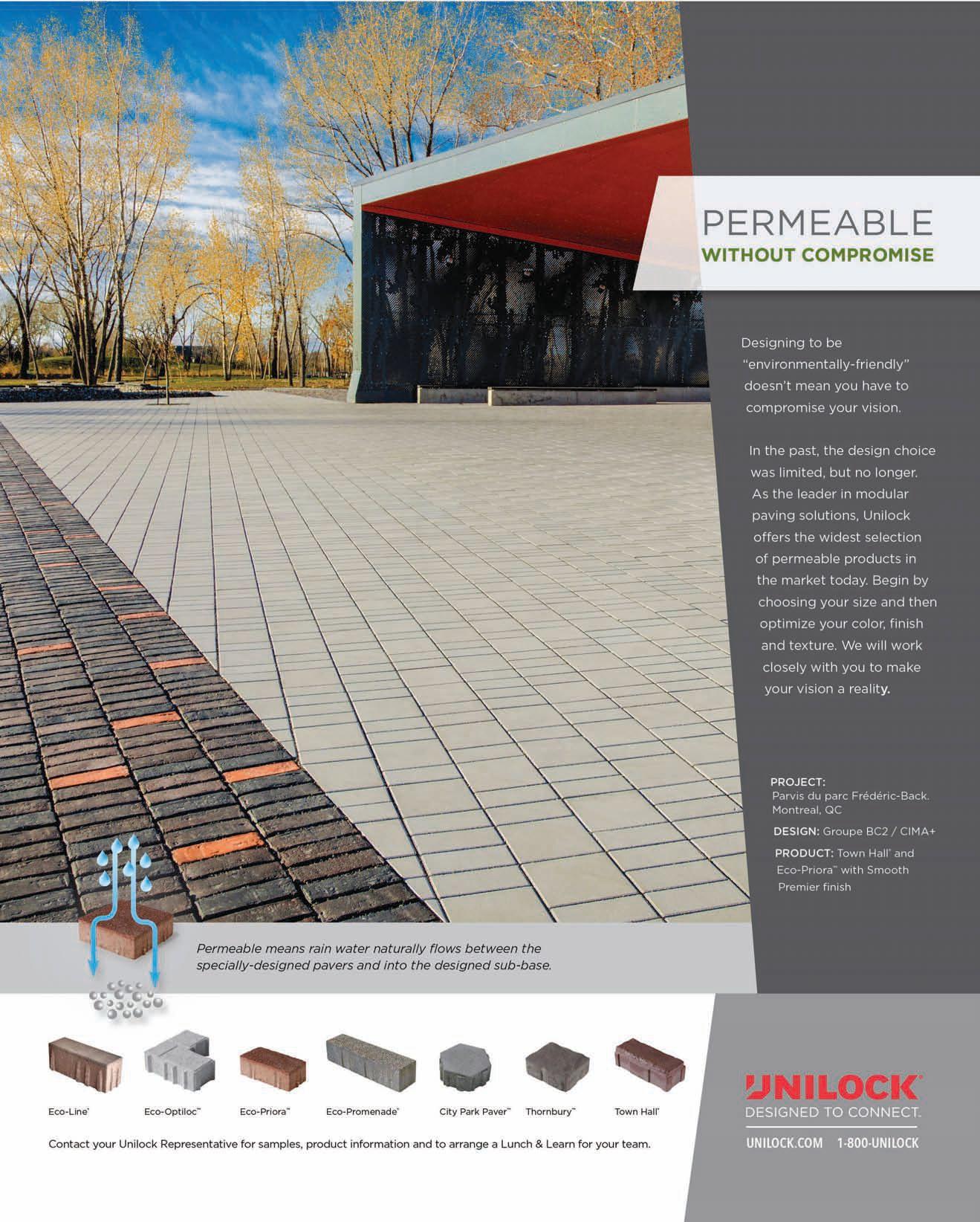
Your ideas matter.
Colorado Green is YOUR magazine! How do we make it better for you? We want to cover topics that the Rocky Mountain landscape industry cares about. Story ideas, media releases and feedback are welcome.

Have you recently had a business-related experience—a surprise audit, a great recruitment success story, an innovation that improved your workfl ow or mistakes that you’d advise others to avoid? Tell your peers and help elevate the fi eld with your knowledge.
Topic areas include: • Green News |Submit your company milestones, anniversaries, awards, and other business news. • Business Sense | Help company owners improve with the knowledge of your experience. • Workforce | Tell us how you are recruiting new employees and retaining/promoting those on staff. • Company profi les | Tell us about your landscape company, how you entered the business, and what keeps you going. • Sustainability | What does sustainability mean in your company? • Technology | How are you using new technology? Or are you using old technology in new or different ways to be more effi cient?





